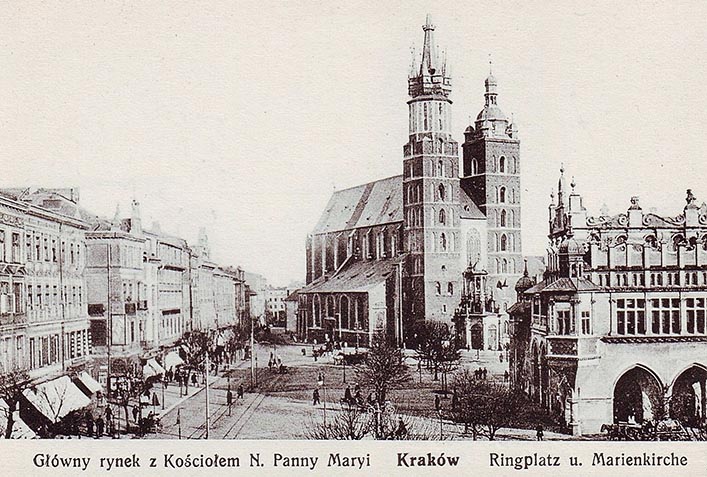 Sukiennice
Sukiennice
Rynek dzielą na dwie części stuośmiometrowe Sukiennice, które obok kościoła Mariackiego i Wawelu są najbardziej znanym symbolem architektonicznym Krakowa. Od swoich XIII-wiecznych początków były przede wszystkim silnym bastionem monopolistycznego handlu krakowskiego oraz miejscem uroczystości miejskich. W XIX w. „awansowały” do szlachetnej roli przybytku kultury. Wewnątrz, gdzie ciągną się w dwóch rzędach kramy z pamiątkami, rękodziełem, biżuterią, dziełami i dziełkami sztuki ludowej, zawsze jest tłoczno i gwarno. Na ścianach widać herby miast polskich oraz godła kupieckie i cechowe. Przed Sukiennicami ustawiono ławki i co jakiś czas przemknie obok nich ochroniarz na rowerze, zaglądając przechodniom w oczy. Po południowej stronie Sukiennic znajduje się wejście do galerii malarstwa polskiego XVIII i XIX w. oraz, tuż obok, do znanej, bardzo popularnej kawiarni Noworolski, w której pod koniec XIX w. spotykała się cała ówczesna elita Krakowa.
Historia Sukiennic
Po lokacji miasta w 1257 r. w Rynku wzniesiono niezbędne do funkcjonowania organizmu miejskiego budynki. Wśród nich rozrastał się dwuszereg kramów kupieckich. Termin camera pannorum (sklep sukienny) po raz pierwszy pojawił się w dokumentach z 1312 r., co zbiegło się z nadanym miastu w 1306 r. przez Władysława Łokietka przywilejem zwanym prawem składu. Polegał on na tym, że każdy kupiec, który przejeżdżał przez Kraków, musiał się tu zatrzymać i sprzedawać kupcom krakowskim swoje towary. Potem mógł jechać dalej. Takie przepisy niezwykle ożywiły i wzmocniły handel krakowski właśnie w obrębie Sukiennic, gdzie przede wszystkim handlowano suknem. W XIV w. za sprawą Kazimierza Wielkiego Sukiennice rozbudowano do trzynawowej hali o długości 108 i szerokości 18 m, a dwa wieki później gruntowny remont po pożarze nadał budowli charakter renesansowo-manierystyczny. XV i XVI stulecie zapamiętano jako czas bujnego rozkwitu Krakowa, prosperity handlu i przyrostu liczby ludności. Nic dziwnego, że w tym właśnie okresie jeden z kupców krakowskich dla usprawnienia ruchu sfinansował budowę przejścia poprzecznego przez halę ze wschodu na zachód, co utworzyło tak zwany krzyż komunikacyjny. W XIX stuleciu w ramach porządkowania miasta o mały włos nie zlikwidowano zapuszczonych Sukiennic. Jednak los dal Krakowowi mądrych rajców i prezydenta Józefa Dietla, którzy postanowili przywrócić handlowej Mekce jej dawną świetność. Młody, zdolny architekt Tomasz Pryliński (popierany przez Matejkę) dostosował Sukiennice do nowego dla nich otoczenia pustego Rynku, dobudował arkady podcieni, udoskonalił wnętrza I piętra, szczyty attyki ozdobił wykrzywionymi niemiłosiernie karykaturami dostojników miejskich, a w całość tchnął sporo pałacowego dostojeństwa.
Galeria w Sukiennicach
Początek galerii dał malarz Henryk Siemiradzki, który w 1879 r. podarował miastu swój pełen dramatyzmu obraz Pochodnie Nerona. Cztery lata później oficjalnie otwarto galerię.
Najwięcej miejsca zajmuje ekspozycja malarstwa Piotra Michałowskiego – wybitnego przedstawiciela romantyzmu, lecz zdecydowanie najwięcej uwagi przyciągają historyczne płótna Jana Matejki: Hołd Pruski, Wernyhora i Kościuszko pod Racławicami. Ponadto wiszą tu obrazy Malczewskiego, Gottlieba, Rodakowskiego, Grottgera, Chełmońskiego, Chmielowskiego (Brata Alberta), Gersona i najstarsze w tej kolekcji płótna pędzla Bacciarellego. Wiele, nie zawsze zdrowych, emocji wzbudzał w swoim czasie promieniujący erotyzmem Szał Podkowińskiego, przedstawiający nagą diwę na ognistym rumaku.
